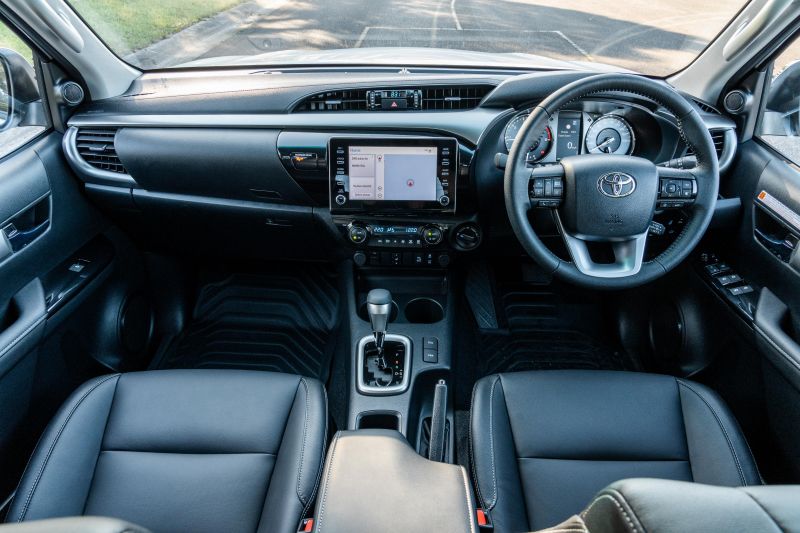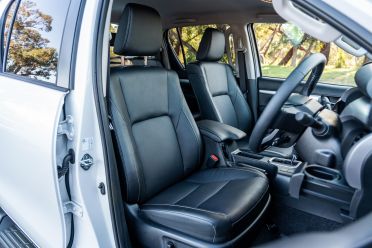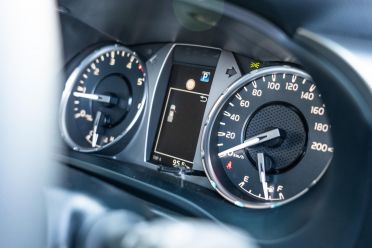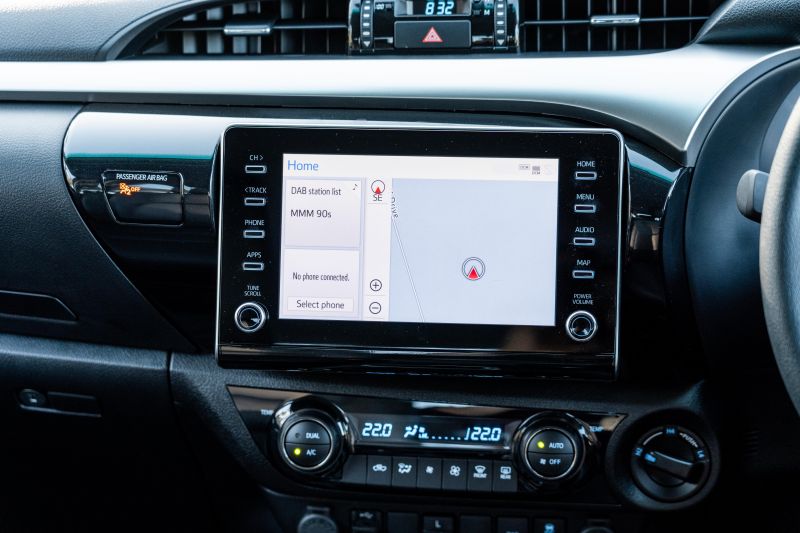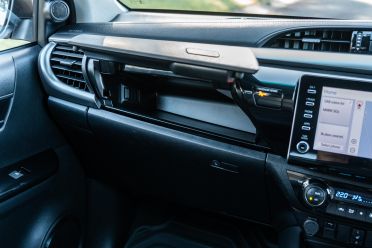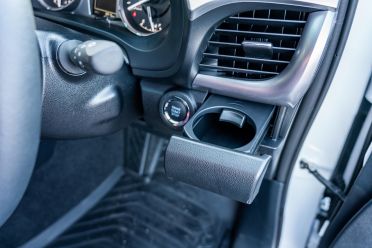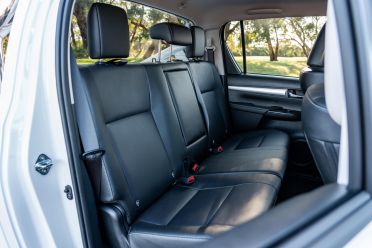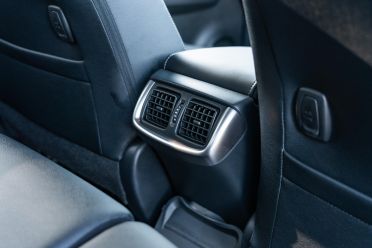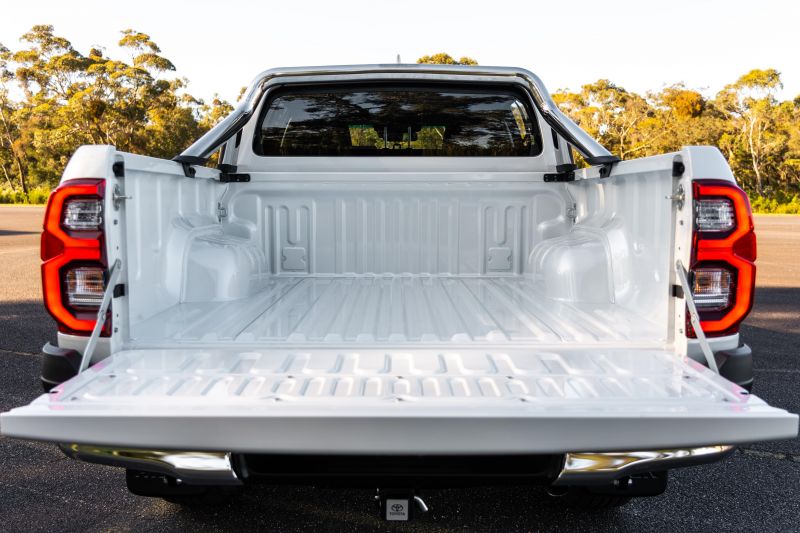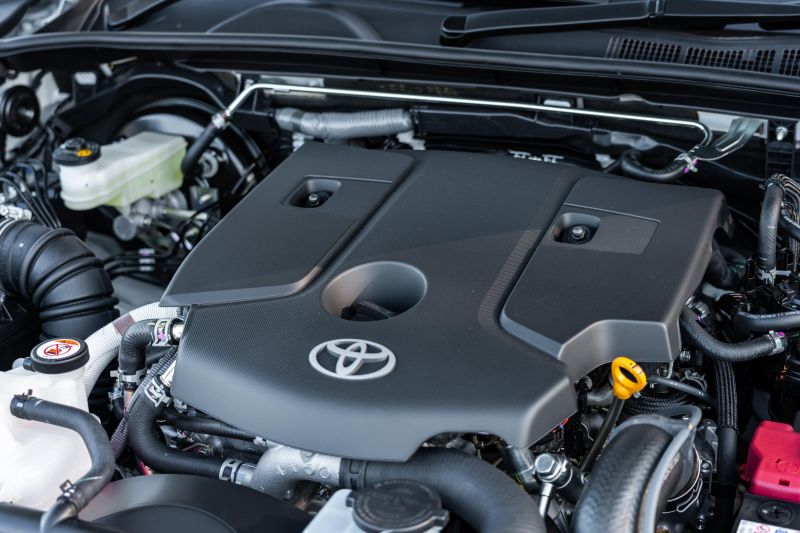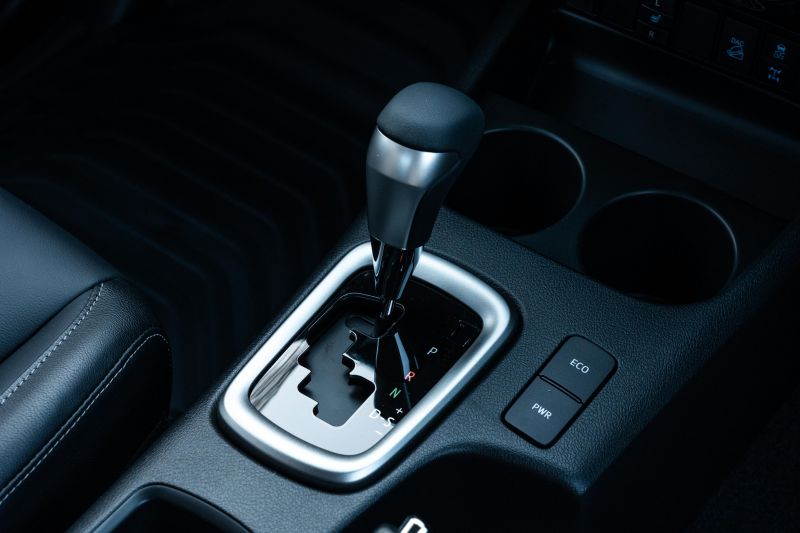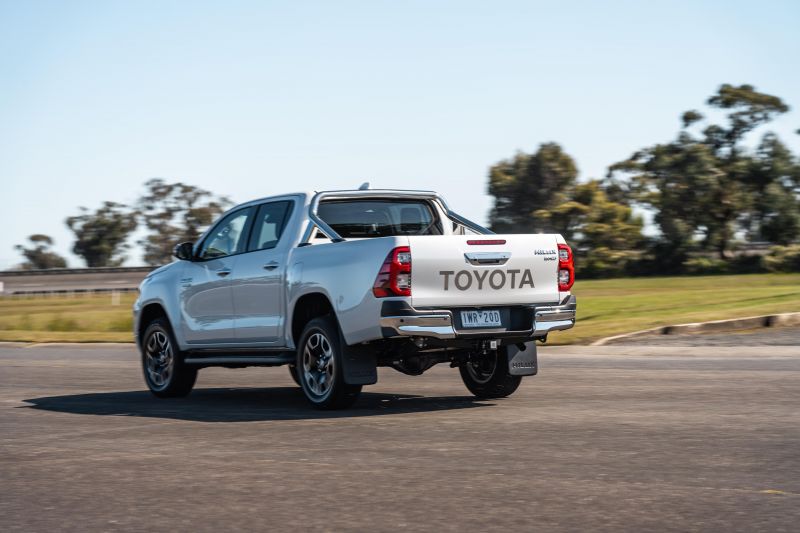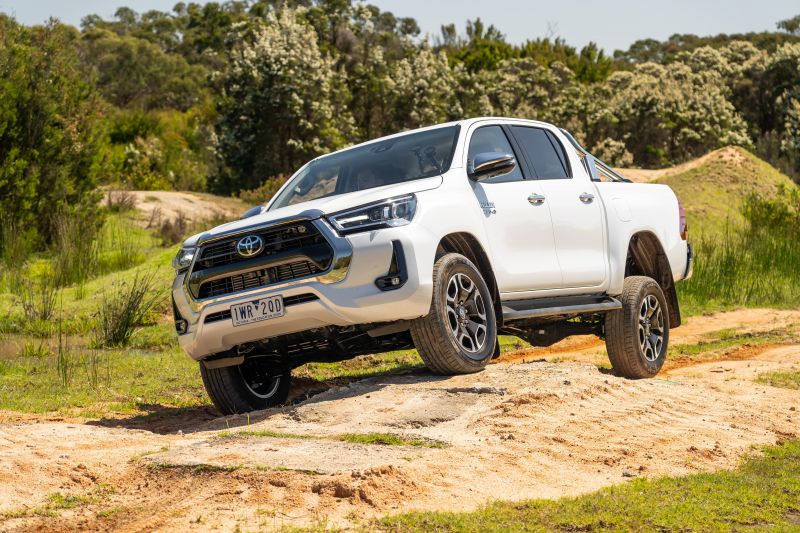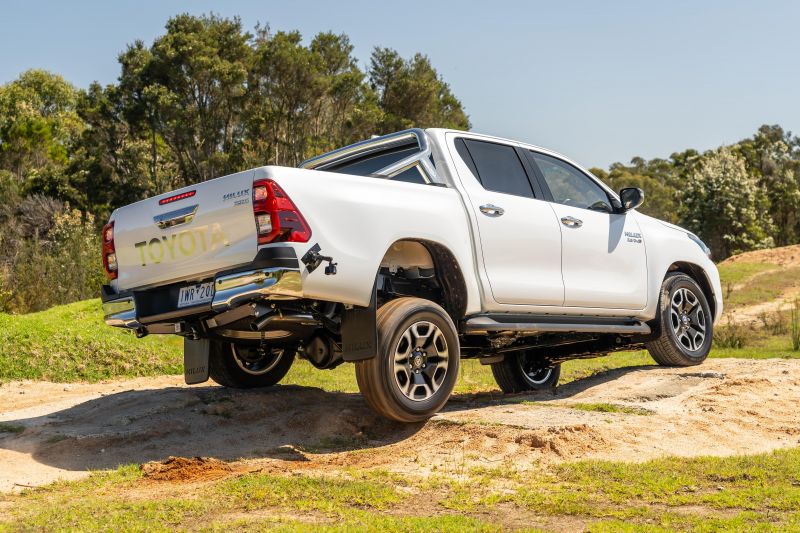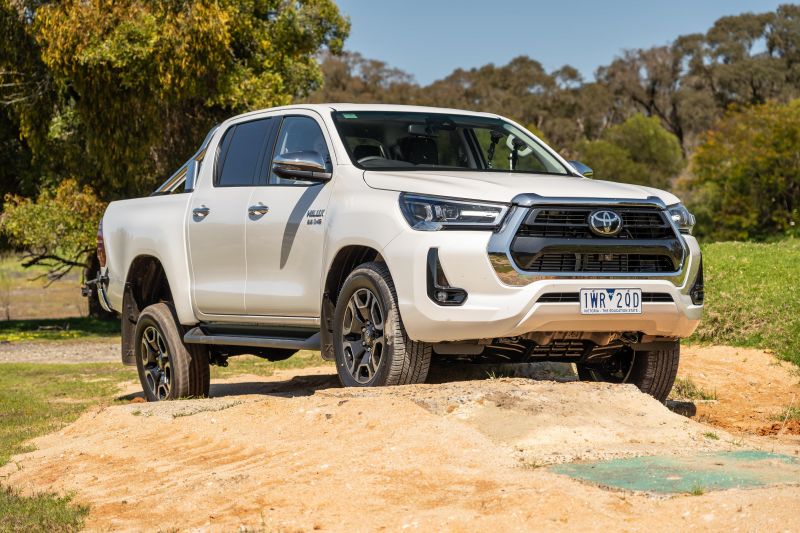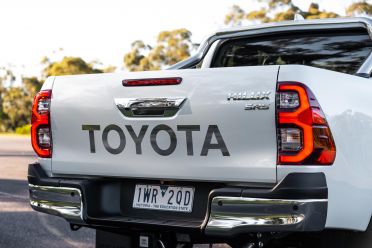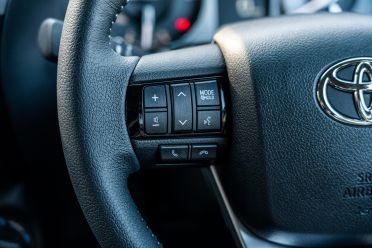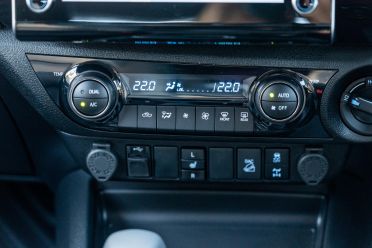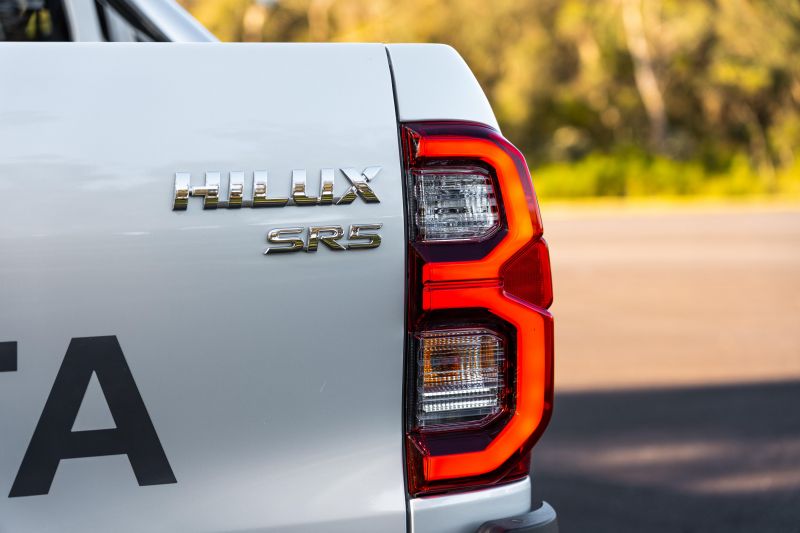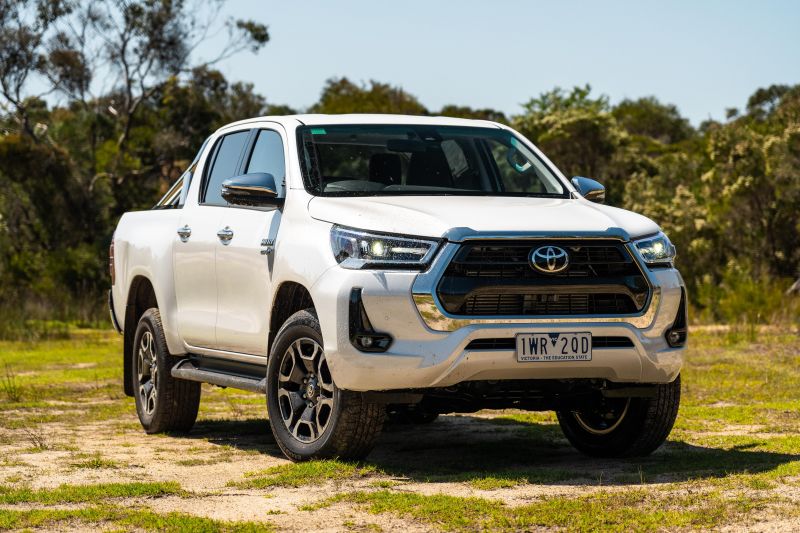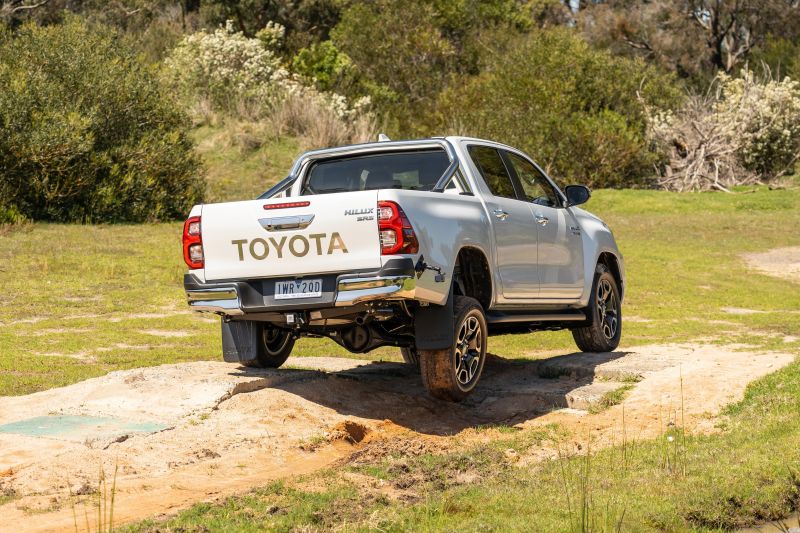The new Ford Ranger has been getting all the headlines lately, but Toyota’s HiLux remains Australia’s favourite ute – and top-selling vehicle overall.
The company has recently launched its 2023 HiLux range, and rather than making wholesale changes to its workhorse, has been content to tweak the spec sheet and keep on trucking.
The HiLux SR5 grade tested here gets a few new mod-cons such as a panoramic-view 360-degree monitor to assist parking or hitching up a trailer, plus a new ID Box anti-theft immobiliser paired to the proximity key.
The 2023 HiLux now comes with driver-assist features found on many of its main rivals, namely blind-spot monitoring lights in the side mirrors, and rear cross-traffic alert. Handy features, but one might say overdue.
Toyota has also given with one hand, and taken with the other – fitting puddle lamps to illuminate the side steps at night, while removing heated side mirrors from the feature list.

How much does the Toyota HiLux SR5 cost?
The 2023 Toyota HiLux SR5 dual-cab in 4×4 guise starts at $59,930 before on-road costs with the manual gearbox, climbing to $61,930 for the automatic tested here. Our test vehicle also had the heated leather seat package fitted, adding $2500 to the price.
Price-as-tested therefore was $64,430 before on-road costs, equivalent to about $69,000 drive-away using Toyota’s pricing calculator with a Melbourne postcode.
That lines it up against the Ford Ranger Sport 2.0-litre Bi-Turbo (about $68,500 drive-away) or Ranger XLT with the V6 diesel (about $69,000 drive-away) – again using Melbourne prices.
Another worthy consideration is the recently updated Isuzu D-Max X-Terrain range-topper which is retailing at the time of writing for $64,990 drive-away nationwide.
By the way, all three of these top-selling utes are subject to months-long waiting lists at the moment, which vary by dealer.
What is the Toyota HiLux SR5 like on the inside?
Well built, practical, and dated. Those are the three words I’d used to describe the HiLux’s interior.
There’s a keyless access proximity key, so you can enter the car while leaving the fob in your pocket – and both steps and A-pillar handles help you clamber up.
The optional leather-trimmed seats offer powered adjustment and heating, but costing extra which at this price point seems harsh. They also lack the Isuzu/Mazda twins’ bolstering.
Ahead of you is a plasticky steering wheel (no bad thing, since supple leather steering wheels in workhorses get damaged anyway) with audio buttons on the left spoke, trip computer and lane-keeping aid buttons on the right, and a small lower cruise control stalk behind.
It reaches for both rake and reach, although this is an almost unanimous feature in today’s ute market.
Behind this sit the analogue speedometer and tachometer, flanking a 4.2-inch trip computer screen that shows your speed digitally, as well as various trip data and driver-assist settings – plus a live speed-sign readout that worked more often than not.
It all looks quite dark and dated – with annoying dust-magnet glossy black trims scattered about, and rock hard surfaces save on the console lid and door armrests – but at the same time it’s screwed together really well and feels very work-ready.
It’s not a ute masquerading as a lifestyle SUV, the HiLux…
The 8.0-inch touchscreen has handy shortcut buttons and dials which are good if your hands are covered in paint, solvent, dirt or whatever else you’ve picked up.
While not offering the most rapid processing power, it covers off the basics in terms of satellite-navigation, wired Apple CarPlay and Android Auto, digital radio (which dropped out often once we were beyond the ‘burbs), plus AM/FM wavelengths and six speakers.
There’s just the one USB plug through (but flanked by two 12V sockets into which you can plug an adaptor for added charging) and the Bluetooth phone call quality received several complaints from people on the other end of the line during my test drive.
While on paper the new panoramic view monitor based on various cameras sounds great for parking or hitching up a trailer, in reality it’s so grainy as to be almost pointless. Certainly next to the new Ranger’s similar 360-degree display, and even the much cheaper GWM Ute’s view.
One thing Toyota does do bloody well is air-conditioning, and the dual-zone climate control feels primed for a stint in Marble Bar as much as Melbourne.
There are also buttons for engaging things such as the hill-descent control and diff lock, and a big chunky twister dial for choosing 4H and 4L 4×4 modes – much better than the Ranger’s fiddly screen-based interface.
You aren’t short of storage: there are two stacked gloveboxes (one that’s ventilated), two open stowage cubbies along the centre tunnel as well as cupholders, a decent centre console with a 220V powerpoint, a rooftop sunglasses bin, pull-out cupholders along the dash ahead of each outboard vent, and bottle-friendly door bins.
The back seat bases flip up 60:40 if you want to use the rear cargo area for tools and things like that, while access is simplified thanks to the side steps and B-pillar grab handles.
There are no rear USB plugs, but you do get vents, bag hooks, a flip-down armrest with cupholders, and acceptable leg- and headroom for two 185cm blokes such as our video tester Paul.
Any taller though (I’m 194cm), and mind you don’t smack your head on the fixed, rather than folding, overhead grab handles that jut out at forehead level.
That tub comes with no bedliner as standard, and lacks a Ranger’s counterbalanced and therefore much lighter tailgate. The tub contains a top-mounted sports bar in chrome, four sturdy tie-downs, and measures 1570mm long by 1645mm wide (1109mm between the arches) by 481mm deep.
Using Toyota-supplied weights, the SR5 auto’s maximum kerb weight is 2110kg and its GVM is 3050kg, suggesting a 940kg payload. However, GVM minus the tare mass makes it 1000kg.
Toyota HiLux Dimensions:
- Length: 5325mm
- Width: 1855mm
- Height: 1865mm
- Wheelbase: 3085mm
- Tracks: 1535mm front, 1550mm rear
What’s under the bonnet?
The 2.8-litre turbo-diesel engine is familiar, making 150kW of power and 500Nm torque, mated to a six-speed automatic transmission, with old school part-time 4×4 including low-range gearing.
Claimed combined-cycle fuel economy is 7.9L/00km and the tank is 80L. Using my math wizardry, this suggests a potential 1000km driving range – if you match the claim, requiring little payload.
The braked-trailer towing capacity is an equal class-leading 3500kg.
Tech Specs:
- Engine: 2.8-litre turbo-diesel four-cylinder
- Power: 150kW @ 3000-3400rpm
- Torque: 500Nm @ 1600-2800rpm
- Transmission: 6-speed auto
- Drive type: Part-time 4×4 with low-range
- Fuel economy claim: 7.9L/100km
- Fuel tank: 80 litres
- Towing capacity: 3500kg braked
How does the Toyota HiLux SR5 drive?
The engine has had its share of dramas, notably with its diesel particulate filter (DPF); but an update to the unit, and the inclusion of a forced burn-off switch for those who don’t get the vehicle up to temperature often, seems to have sorted this issue on new models.
With 150kW of power and a meaty 500Nm of torque, it lacks neither on paper nor in reality, with excellent low-down tractability (peak torque from only 1600rpm) and a decent mid-range – although it tapers a bit at higher speeds, hurting the 80-120km/h overtaking test.
We pulled a 10.5 second 0-100km/h time, and a 7.5 second 80-120km/h simulated overtake – unladen, on a closed facility.
One way to get more instant response off the mark is the hit the PWR (short for Power) button, which sharpens accelerator pickup. You can also shift the transmission to S-for-sport mode in which it holds lower gears, keeping the engine on the boil for better response.
The six-speed auto has the odd slightly jarring shift but is generally decisive. I’m not convinced of the need for a 10-speed auto.
We should also caution that our SR5+ test vehicle had not been run-in, with less than 100km on the odometer. Which means it felt very tight, and perhaps excused the 10.4L/100km fuel use figure we saw – well above the claim.
In terms of refinement, it’s neither the rattliest or the quietest in class, and around town lacks idle stop/start.
While the HiLux has a reputation for a shocking unladen ride from the rear solid, leaf-sprung axle, a previous update toned the tub down a lot, and it’s nowhere near as hop-happy or stiff at the back as it once was.
Less ideal was the Toyota’s propensity to lack top end body control over high speed sine wave undulations at our test track, as our video shows. Poor Paul looked like he was aboard a tinny in a storm, pogo-ing up and down.
Still in my experience, HiLuxes are at their comfiest with 300-500kg onboard. Which is fine except for the fact that most competitor utes handle loads well while offering more daily comfort when not actively lugging stuff. Engineering is all about compromising in the right places.
Unlike some (but not all) rivals now, the HiLux keeps rear drum brakes, though in fairness the front discs do most of the heavy stopping work.
The 4WD system remains part-time and defaults to rear-drive on roads, with low- and high-range 4×4 settings controlled by a chunky dial. The low-range requires you to shift into neutral, and engages swiftly. It’s also the setting for when you’re calling on the rear locking diff.
The HiLux does offer excellent off-road ability with plenty of diff and step clearance over rocks, good approach (29 degrees) and departure (27 degrees) angles, a very tractable diesel with predictable accelerator and brake feel, ok outboard visibility, and communicative hydraulic power steering.
We’ve little reason to doubt that this is one ute you can put through its paces without too many concerns – which is what a good reputation and decades of work gets you. The HiLux is also subject to pretty much the widest array of aftermarket 4×4 mods money can buy.
In terms of driver-assist aids, the fitment of blind-spot monitoring lights in the side mirrors is long overdue, while the lack of an electric power steering system means the lane-keeping aid uses selective wheel braking to jolt the car inside the road lines.
It’s a little abrupt, but you know what? It actually does work fairly predictably.
Tech Specs:
- Kerb weight: 2110kg
- Gross combined mass: 5850kg
- Front suspension: Double wishbone
- Rear suspension: Leaf springs
- Front brakes: Ventilated disc, four-piston callipers
- Rear brakes: Drums
- Tyres: 265/60 R18
- Ground clearance: 226mm
- Steering type: Hydraulic assist
What do you get?
Outside
- 18-inch alloy wheels
- 265/50 R18 highway terrain tyres
- Full-size spare
- Chrome step-type bumper
- LED headlights, auto-levelling
- Part-LED tail lights
- LED daytime running lights
- Privacy glass – rear
- Side steps
- Stainless steel sports bar
- Chrome door handles
- Shark fin antenna
- Tow bar
- Heavy duty suspension and underbody package
- Rear diff locker
- Parking sensors front and rear
- Puddle lights
Inside
- Fabric seat trim
- Premium gear knob and wheel trims
- Floor carpet
- All-weather floor mats front and rear
- Air-conditioned centre console
- Lockable glovebox
- 4.2-inch digital trip computer
- Dual-zone climate control
- Rear air vents
- Proximity key entry and button start
- 220V powerpoint accessory socket
- 8.0-inch touchscreen display
- Satellite-navigation
- Digital radio
- Wired Apple CarPlay, Android Auto
- USB-A point and Bluetooth phone/audio
- 6-speaker audio
- Three-years Toyota Connected Services
- Stole vehicle tracking
- Automatic collision notification
- SOS Emergency Call
Fitted options
- SR5+ Premium Interior – $2500
- Leather seat trim
- Heated front seats
- Power-adjustable driver’s seat
Toyota also offers a bewildering array of factory accessories, many of which were designed in Australia.
You can get numerous designs of bull bar, canopy and racking; hard-wearing canvas seat covers; an auxiliary battery kit under the bonnet, light bar, tub protectors and more.
Is the Toyota HiLux SR5 safe?
Crash-tester ANCAP gives the HiLux five stars with a 2019 date stamp, and sub-scores of 96 per cent for adult occupant protection, 87 per cent for children, 88 per cent for vulnerable road users, and 78 per cent for safety assist features.
Standard safety features:
- 7 airbags
- Rear bench top-tethers and ISOFIX points
- Surround-view camera display
- Autonomous emergency braking (AEB)
- Vehicles
- Pedestrians
- Cyclists in daytime
- Lane departure alert by braking
- Road sign assist
- Adaptive cruise control
- Blind-spot monitoring
- Rear cross-traffic alert
How much does the Toyota HiLux SR5 cost to run?
Toyota’a factory warranty is five years and unlimited kilometres, which Toyota will extend to seven years for the engine and driveline so long as you stick to the service schedule.
Toyota is one of the few brands to retain six-month or 10,000km service intervals. On the plus side, the first six visits are each capped at $260.
Still, even lower-mileage operators will need to be at the workshop at least twice a year, meaning more hours off the road.
CarExpert’s Take on theToyota HiLux SR5
Buyers of workhorse vehicles – private or business – are often creatures of habit, and understandably so. These vehicles are vital parts of their livelihoods, and that will make anyone risk-averse.
There’s no doubt whatsoever that the MY23 HiLux SR5 is a better vehicle than it was a few years ago, with regular updates keeping it competitive as its years lengthen. And for those who like their ute to feel like a simple truck rather than a tubbed SUV, the Toyota delivers.
However, compare the HiLux to a new Ranger and it gets hard to find areas where the Toyota stacks up better, really. Likewise – though to a lesser degree – against the Isuzu D-Max and its Mazda BT-50 twin.
The HiLux therefore remains a middle-of-the-road offering with a top-level reputation. That doesn’t automatically mean you shouldn’t buy another one, it just means you should be aware of the ute market’s wider context.
Click the images for the full gallery
MORE: Everything Toyota HiLux






